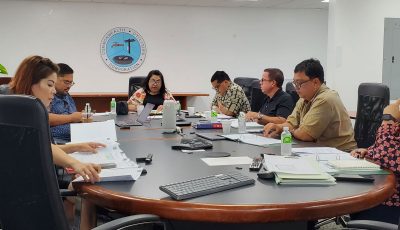BASED ON PERMIT PROJECT DATA
CUC power supply ‘only good to 2017’
Decisions have to made now on how the Commonwealth Utilities Corp. will carry the power demands of the influx of development within the next two years, according to CUC acting executive director Gary Camacho yesterday, as the utility eyes much needed fixes to a damaged power plant engine and aggressive improvements to 30- to 35-year-old facilities.
CUC’s short-term plan—to address problems with Power Plant 1—will ensure that the islands’ continued base load of 75 megawatts is enough to sustain any development and power supply “only until 2017.”
This, though, is based on project chart details provided to the Senate for development plans throughout 2015 to 2016 that could vary and change on how development plans play out.
The projects include construction or renovation at the Kensington Hotel Saipan, Grand Mariana Casino and Hotel Resort, Honest Profit Saipan Resort Hotel, Ocean Vista Resort, Tinian Ocean View Resort Casino, Plumeria Resort (Tinian), Surfrider Resort and Spa and Beach Club, HS Lee Commercial Building, Villora Condotel Residence, Saipan Comfort Homes, Rota Municipal Dump, Kanadan Magpo Homestead (Tinian), and the Beach Road Route 33 Improvement Project.
Led by Sen. Arnold Palacios (R-Saipan), the Senate called on the first agency in a series of hearings with permitting agencies to ask how the CNMI government will grapple with projects the Senate believes will be of “monumental adverse impact” to the existing infrastructure and the environment.
CUC presented a “system improvements to facilitate CNMI project developments” plan yesterday, as called on by the Senate committee on in earlier letters to CUC, the Bureau of Environmental and Coastal Quality, and the Department of Public Works.
DPW and BECQ will answer to the Senate today at a 9am meeting.
Palacios wants answers on how the six or seven major developments on the drawing board or permitted under the Coastal Resource Management “umbrella” major siting permit, signed off on by regulatory agencies for island projects, will affect the island.
“We wanted to make sure we are appraised of the present state of different infrastructure of the Commonwealth,” said Palacios, in his opening remarks yesterday. Palacios wants to know “if agencies have the capacity” to carry on demands “without adverse impacts” or if they need “improvements” to increase power, water, or wastewater demands.
Sen. Sixto Igisomar (R-Saipan), for his part, stressed an apparent lack of communication between agencies and a lack of networking, as the detailed in CUC’s report.
“I hope we are able to communicate or dialogue today,” said Igisomar said, and “set the story straight.”
Speaking to senators on “volume” of increased demand in power and water yesterday, Camacho said, “The boom has come at a rapid pace.”
“An entire power system improvement and expansion in distribution and hardware size is the solution to this concern,” Camacho said during his presentation.
As more developments come on board on Saipan, Tinian, and Rota, Camacho said, “even more problems arise” and CUC’s capacity has to be increased.
“Understand too that the number of these facilities are aged so in some point in the future would have to be replaced,” Camacho said.
Camacho said reserves has been adequate, but is a costly aspect of their program.
CUC has four power plants on Saipan, and one each on Rota and Tinian. Saipan’s power plant “2” is not operational.
Saipan has a total capacity of 95.05 megawatt “in design” but has available 56.6 megawatts.
Peak demand months in previous years were July 25, 2013, were CUC hit 34.7 MW; June 12, 2014, at 34 MW; July 1, 2015, at 36.3 MW. The peak for 2016 is Jan 27 30.7 MW, but CUC acknowledges they did not hit the peak months of July and June yet.
CUC has 25.7 megawatts in reserve.
Engine one to four at PP1 put out 6 MW each, but carry design capacity of 7.77. And also due to “age,” engines five to eight can produce 10 MW, out of a design capacity of 13. That’s 48 MW out of intended 81.24 MW, in total.
“Engine number 8 has severe damage on it…it will take a significant amount of time and cost into the millions to repair that particular unit,” Camacho said.
PP4 is at peak demand and has a total 14.4 MW capacity but currently has a 8.6 MW reserve, he added.
The engines on Saipan currently in use are 20 to 35 years old and “increased maintenance and unreliable parts supply” result from the age these units.
Engine eight, for one, needs foundation reaper, among others.
But the engine’s original equipment manufacture, Camacho said is unable to supply the parts before 16 months, with a commission schedule over 24 months, or “two years if we were try to repair that unit.”
CUC needs a short-and-long-term plan, Camacho.
Short-term would be to conduct major repairs in PP1. And repair and replacement of all existing units “need to be considered aggressively.”
“Buying a new unit to deal with” engine number 8 “to deal with existing demands or upcoming short term demands,” Camacho said, “is more efficient” and would be commissioned “within nine months rather than the two year repair process for that current engine.”
“Decisions needs to be made now,” Camacho said, citing the length of time to procure engines.
The short-term plan will ensure that the continued base load of 75 megawatts is enough to sustain any development and power supply only until 2017, this is according to the information provided to BECQ, which they shared to the Senate as a development plan.
“If those plans change then obviously then the timelines change,” Camacho added.
Tinian also has “huge reserve capacity,” Camacho said.
But, he added, “that reserve capacity would almost be nil in six years if the Alter City plans move forward and become realistic. In fact, by the end of their last phase, there will be an additional 10 megawatts required to meet that demand.”
There is almost “zero reserve next year if the plans are correct,” said Camacho. “We need have to close communication with these developers. When it goes to its last stage, it goes off the charts,” Camacho said, referring to a provided chart on power demands on Tinian. “This is where we need the additional 10 megawatts.”
Camacho added it was the “same situation” on Rota. “They are in good shape,” Camacho said of Rota.
In the next two years, Camacho said, “We are only dependent on information provided to CRM” but that they “need to make decision now” as demands are noweher near what it was two years ago.
It will come to a “point where another power plant is required although there is a 17-megawatt reserve today,” Camacho said.
“We can only do this together,” he added.
On costs—responding to a question from Sen. Frank Cruz (R-Tinian)—Camacho said, per industry standard, it would cost a “million dollars a megawatt.”
“This is substantial,” Camacho said.
Camacho said for long-term plans, this is where CUC “greatly needs assignee” to move on from a 30 to 35 MW facilities to a new program altogether.
According to CUC’s PowerPoint presentation yesterday, a “long term plan”—from 2018 to 2040—would require 10 new engines on Saipan for an 80 MW capacity and associated hardware. On Tinian, this would require 20 megawatts, with four 5-megawatt engines. On Rota, they would need 3 megawatts and phase out old units.



























